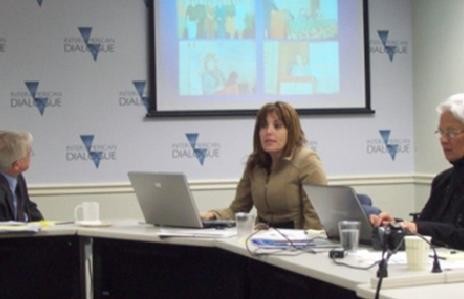
National Conference on Teacher Policy in Costa Rica
Workshop that seeks to promote debate on teacher policy and showcase innovative policies.
This post is also available in: Spanish
With the news and debate about the increase of unaccompanied minors from Central America (El Salvador, Guatemala and Honduras) to the United States emerged a discussion surrounding the ‘root causes’ of the crisis. While the discussion has somewhat dissipated because the crisis is no longer such a political problem, two issues must be considered in light of the recent Central American governments’ proposal of the Plan of the Alliance for Prosperity in the Northern Triangle. The plan proposes investments in infrastructure and energy, yet it is important to pay attention to some determining factors that have driven migration and its immediate solutions.
A few facts to consider:
It is no accident that people are moving out of fear and lack of opportunities. There is a crisis, and it is not one of lack of holding facilities in the United States, but rather one of poor economic performance in Central America. The region’s existing economic growth model is obsolete and a partial cause of this crisis, and thus needs to be reconsidered. An economy that heavily relies on agricultural exports is condemned to poverty and backwardness: Central America has only grown when prices of coffee or bananas go up. The region needs to move from being a ‘desert economy’, into a ‘knowledge-based economy’.
The economics of migration are not yet leveraged for development, and they can bring a silver lining to this entire crisis. The flow of remittances into Central American countries increases disposable income and creates a stronger saving capacity among households. In the US, migrants also consume billions of home country products that create and nurture a value chain that increases productivity in the region. Just check today’s foodstuff in US supermarkets.
In my view, a development approach to the problem of unaccompanied child migrants should involve an asset-building strategy based on partnerships between national and local governments, the private sector, civil society and US development aid. Such an approach should focus on the municipalities where migration originates as well as on implementing projects and promoting policy dialogues through nationwide efforts, so that governments take migration seriously.
The asset-building approach must target:
As a first step, it is important to increase school retention in those communities where migration originates. This should specifically involve the establishment of school retention programs in partnership with local schools and other players (such as NGOs specializing in education, and banking institutions that pay remittances and whose managers are respected and influential in their communities).
Such programs should: (i) increase time in school by 60 minutes a day consisting of extracurricular or aftercare activities; (ii) provide snacks to kids in schools; (iii) test student performance and foster general knowledge of the significance of those tests for society; (iv) offer tutoring classes; (v) increase parent participation through various modes of engagement, particularly electronic means (use of web-portals, skype, social media, etc.) for those parents living abroad; (vi) motivate migrant parents to invest in their children’s education through mechanisms such as money transfer operators or crowdfunding platforms; and (vii) increase community engagement in school activities through discussion forums on education performance.
The following table provides an example of the potential impact of school retention programs using the case of Honduras, where 50% of nationwide school enrollment is in municipalities from which unaccompanied minors originate. Even if programs were implemented in only 40 schools in Honduras, this strategy could serve at least 20,000 kids and would have a demonstrative effect nationwide.

Given that the current economic growth model is based on the reliance on low-skilled agricultural labor or on a labor force servicing small markets or enclave economies (like tourism and maquilas), it is critical to build skills for a more competitive economy. The international community should work in tandem with the region’s governments and businesses to strengthen entrepreneurial skills of small businesses and to widen the skills of the labor force.
This should include: (i) support for entrepreneurial skills in local communities (value chain integration, business model adoption, making bureaucratic processes more efficient); (ii) expand the number of trades offered by technical schools; (iii) increase knowledge on global markets; (iv) bring vocational schools into the local communities; and (v) teach English as a second language and computer skills for the digital economy.
Together with efforts to reduce informality and increase savings mobilization and access to credit, these activities will help getting parents, families and households in the community to concentrate on education as a tool for development.
The proposed approach does not have a ‘security’ component partly because the level of investment in security has historically been far greater than that in development, and it is therefore important to balance both. However, by retaining kids in school and invigorating the local economy with additional capital, the potential of exposure of the population to crime will be mitigated.
Workshop that seeks to promote debate on teacher policy and showcase innovative policies.
PREAL reviews broad spectrum of its activities and discusses priorities for improving education policy in the coming year.
Progress of Latin American countries and the Caribbean towards the six Education for All goals.
